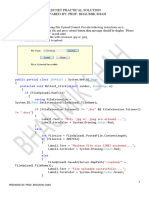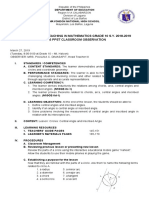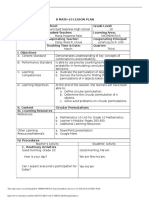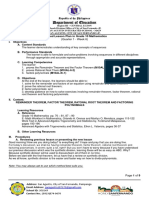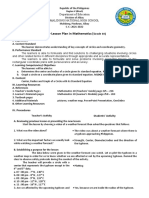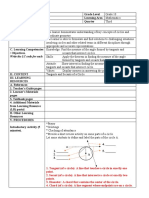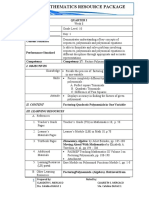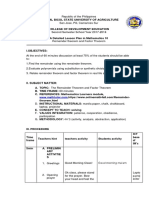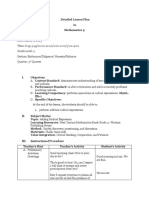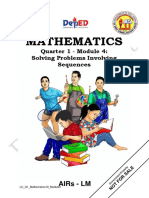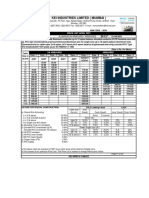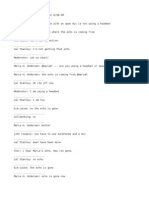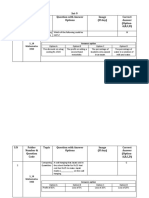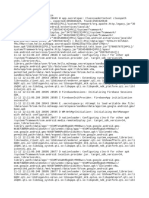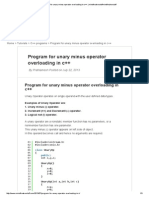DLP - Problems Involving Polynomial Functions
DLP - Problems Involving Polynomial Functions
Uploaded by
Crystal Shane Dela CruzCopyright:
Available Formats
DLP - Problems Involving Polynomial Functions
DLP - Problems Involving Polynomial Functions
Uploaded by
Crystal Shane Dela CruzOriginal Title
Copyright
Available Formats
Share this document
Did you find this document useful?
Is this content inappropriate?
Copyright:
Available Formats
DLP - Problems Involving Polynomial Functions
DLP - Problems Involving Polynomial Functions
Uploaded by
Crystal Shane Dela CruzCopyright:
Available Formats
DETAILED LESSON PLAN IN MATH 10
I. OBJECTIVES
At the end of the session, the students are able to:
Identify the polynomial function that represents the given word problem
Solves problems involving polynomial functions
II. SUBJECT MATTER: Illustration of Polynomial Functions
References: Mathematics 10 Module, p.2; https://www.youtube.com/watch?
v=Fi3KQYzwNTg
https://www.youtube.com/watch?v=aruI7HGj8kA
Materials: Visual Aids
Chalkboard and chalk
III. PROCEDURES
Teacher’s Activities Student’s Activities
A. Preliminary Activities
Everyone, please stand as we pray. The assigned student for the opening prayer
Prayer leader, please take the lead. will lead.
Good morning, class! Good morning, Ma’am Crystal!
Please be seated. So, how are you We’re doing great Ma’am.
today?
It’s nice to hear that from you. But
before anything else, class
secretary, kindly check the
attendance and mark all those who
are absent for today. Thank you! (class secretary will check the attendance)
B. Review
Before we proceed with the
discussion proper let’s have a recap.
During your first quarter, we have
discussed about polynomials.
A polynomial is an algebraic expression, or
Can anyone in the class define what
group of expressions separated by “+” and
is a polynomial?
“-“ signs, whose exponents of the variables
are non-negative integers
C. Motivation
Since you were able to
define what is a polynomial,
Let’s play a game called
FACT or BLUFF.
(Students will be raising their hands to
Identify whether the answer as these examples are presented on
following expressions are board)
polynomial or not.
3
1. 2 x yz
3x FACT
2. BLUFF
y
3. 8 x 3+ 2 x −5 FACT
4. 9 x 5 − 10 x 4 + 5 √ x +2 BLUFF
BLUFF
5. −7 x − 2 −100
Excellent! Just remember that
polynomials have restrictions:
a.) no variables with positive
exponent should appear in the
denominator and no variable
with positive exponent should
appear in the numerator;
b.)variables should n ot appear
under radical sign; and
c.)variables should not have a
fractional exponent.
Try to also recall that
polynomials are also named Yes Ma’am, beause it has 1 term.
according to its
number of terms. Example 1 is
a monomial, right class?
Very good! how about It’s binomial, Ma’am.
Example 5, an expression
consisting of 2 terms?
Great! What about an
expression consisting of 3 It’s trinomial, Ma’am.
terms, just like Example 3?
Now that you are able to
identify expressions which are
polynomials or not, Let us row
the boat as we discover new
learning.
Are you ready? We are ready, Ma’am!
D. Lesson Proper/ Discussion
What have you noticed in our first We identify a polynomials, Ma’am.
activity today?
Great! The idea you have in mind
just formulate our topic for today.
In this lesson, we will be
Illustrating Polynomial
Functions.
So, let us first define what is a
polynomial function.
A polynomial function is a function
of the form
n n −1 2
P( x )=a n x +an − 1 x +...+a2 x + a1 x +a 0
; where n is a non negative integer, x
is a variable and a n,a n− 1,…,a 2, a 1,
and a 0 are real numbers.
Polynomial functions make use of the
function notation like P(x) read as “P
of x”, f(x), g(x) and the like or
sometimes we use y equals a certain
Polynomial
In writing the standard form of
polynomial function, the highest
degree of terms will be written first
followed by the next degree and so on.
The exponent of the variable (or sum of the
exponents if there are more than one
variables) is the degree of the term. The
highest degree in a group of term is the
degree of the polynomial expression.
The term containing the highest exponent
is called the leading term . Meanwhile, the
real numbers in a polynomial function is
are called coefficients. The coefficient of
the leading term is called leading
coefficient
Presented in a table, we will write
polynomial functions in standard form
and determine the degree, leading
term, leading coefficient, and constant
of a polynomial function.
Standard Leading Leading Constant
P(x) form
Degree
term Coefficient Term
− 9 x +3 x 24−
−22 xx33++3
x4 4x 2 − x94x 1 0
(student may be called once in a while for
3 8 8 3 8
7 x − 3 x 6+6
x x− 3+18
x +7
8
x +18
6x 6 18
some small questions in answering the
2
5 x − 3 x 3+1
2
x +5 x +1
2
−3 x
2 -3 1 Item to emphasize a learner-centered
environment)
Any questions, Class?
None, Ma’am
Illustrations of polynomial functions
can also be seen in real-life objects.
(Answers of students may vary)
Since polynomials are used to describe
curve of various types, people use them
in real world to graph curves.
Engineers use polynomials to graph
curves of bridges.
(The following photos will be presented
to students in class)
In this illustration, roller coaster
designers may use polynomials to
describe the cruves in their rides.
Can you give other objects where
polynomial functions can be
represented?
(Answers of students may vary)
Excellent! Do you have any questions
regarding our discussion?
E. Application
None so far, Ma’am.
If you don’t have any questions,
let’s have an activity. You will be
paired with your seatmate. Student
A will construct his own example
of polynomial functions and then
Student B will try to determine the
parts of a polynomial function (the
degree, leading term, leading
coefficient, and constant of a
polynomial function), and vice
versa.
F. Generalization
Asked the class about the lesson
discussed in today’s lesson.
IV. Evaluation
Fix and Move them, then Fill me up!
Considering the given polynomial functions to fill in the table.
P(x) Standard form Degree Leading term Leading Coefficient Constant Term
1.
f ( x)=2− 11 x +2 x 2
2.
3
2x 5
f ( x)= + +15 x
2 3
3.
f (x)= x(x 2 −5)
4.
y=− x (x+3)( x −3)
5.
2
y=(x +4)( x +1)( x −1)
Prepared by:
Crystal Shane E. dela Cruz
PST-PSAU
You might also like
- Practical Solution Bhshah-IiDocument11 pagesPractical Solution Bhshah-IiCypher GamingNo ratings yet
- Lesson Exemplar: Illustrates The Center-Radius Form of The Equation of A CircleDocument10 pagesLesson Exemplar: Illustrates The Center-Radius Form of The Equation of A CircleAn ObinaNo ratings yet
- Math 10 q3 Week 7 Module 6 Illustrates The Probability of A Union of Two Events For Reproduction 3Document22 pagesMath 10 q3 Week 7 Module 6 Illustrates The Probability of A Union of Two Events For Reproduction 3EJ MianoNo ratings yet
- g10 DLP q2 Week 1 Day 4Document9 pagesg10 DLP q2 Week 1 Day 4Lourdes de JesusNo ratings yet
- Mathematics Resource Package: Quarter I Subject: MATH Date: - Day: 2 Content StandardDocument7 pagesMathematics Resource Package: Quarter I Subject: MATH Date: - Day: 2 Content Standardkris kaye morenoNo ratings yet
- Bambad National High SchoolDocument3 pagesBambad National High SchoolEdcel Ladrillo Bagsic100% (3)
- Volvo CatalogDocument61 pagesVolvo CatalogLuis AlapazNo ratings yet
- Polynomial Functions LP #2Document4 pagesPolynomial Functions LP #2Panugan RuSseL100% (3)
- LP Math 10 Aug 13-15 2019Document4 pagesLP Math 10 Aug 13-15 2019jobelleNo ratings yet
- Lal-Lo Campus: 7 E'S ActivityDocument3 pagesLal-Lo Campus: 7 E'S ActivityNorielyn EspejoNo ratings yet
- Detailed Lesson Plan On Arithmetic SequenceDocument9 pagesDetailed Lesson Plan On Arithmetic SequenceHusnulNo ratings yet
- Math 10 Lesson Plan 2Document2 pagesMath 10 Lesson Plan 2Red Zye Ubay50% (2)
- Problems Involving Polynomial FunctionsDocument5 pagesProblems Involving Polynomial FunctionsJerson Yhuwel100% (2)
- Central and Inscribed AnglesDocument5 pagesCentral and Inscribed AnglesIrene MagatNo ratings yet
- Learning Competencies Lesson No. 1: Quadratic Equations: What You'll LearnDocument2 pagesLearning Competencies Lesson No. 1: Quadratic Equations: What You'll LearnRonald Almagro100% (1)
- Graphing Polynomials Lesson Plan and MaterialsDocument9 pagesGraphing Polynomials Lesson Plan and MaterialsThomas Gribble100% (4)
- DLP Week 5 CIRCULAR PermutationDocument8 pagesDLP Week 5 CIRCULAR PermutationRoda Doctor0% (1)
- Applying The Distance Formula To Prove Some Geometric Properties - FINALS FIXDocument7 pagesApplying The Distance Formula To Prove Some Geometric Properties - FINALS FIXAxis ViloriaNo ratings yet
- Luciano Millan National High School: A Semi-Detailed Lesson Plan in Mathematics 9Document3 pagesLuciano Millan National High School: A Semi-Detailed Lesson Plan in Mathematics 9Jessie OlantigueNo ratings yet
- Theorems On Two Intersecting ChordsDocument5 pagesTheorems On Two Intersecting ChordsJay100% (1)
- CO1 Lesson PlanDocument3 pagesCO1 Lesson PlanJeanie Pe100% (3)
- DLP Distance FormulaDocument5 pagesDLP Distance Formulaalger clerigo100% (2)
- Department of Education: Detailed Lesson Plan in Grade 10 MathematicsDocument9 pagesDepartment of Education: Detailed Lesson Plan in Grade 10 MathematicsBaby DmNo ratings yet
- Detailed Lesson Plan in Math 10 (Finding The Unknown Variables in An Arithmetic Sequence)Document4 pagesDetailed Lesson Plan in Math 10 (Finding The Unknown Variables in An Arithmetic Sequence)Reygie Fabriga100% (4)
- Lesson Plan in Mathematics 10 1st QuarteDocument6 pagesLesson Plan in Mathematics 10 1st QuarteJames Russell AbellarNo ratings yet
- Detailed Lesson Plan in Lesson 2-Graphs of Quadratic Function 2.3 (MATHEMATICS 9)Document8 pagesDetailed Lesson Plan in Lesson 2-Graphs of Quadratic Function 2.3 (MATHEMATICS 9)Richelle Jane Calanao100% (1)
- Inscribed Angles Lesson PlanDocument9 pagesInscribed Angles Lesson PlanRuth Cadaweng Tindowen100% (1)
- Demo in DecileDocument5 pagesDemo in DecileLyceljine C. Tañedo100% (1)
- DLP Quadratic Square TrinomialsDocument6 pagesDLP Quadratic Square TrinomialsDiane BanoNo ratings yet
- Grade 10 Daily Lesson Log School Grade Level 10 Teacher Learning Area MATHEMATICS Quarter SecondDocument11 pagesGrade 10 Daily Lesson Log School Grade Level 10 Teacher Learning Area MATHEMATICS Quarter SecondMichael Beniga0% (1)
- Lesson Plan in Mathematics 10Document4 pagesLesson Plan in Mathematics 10Jerson Yhuwel100% (1)
- M10Sp-Iva-1: Laptop, LCD Projector, Speaker With Microphone, Manila Paper, Pentel PenDocument4 pagesM10Sp-Iva-1: Laptop, LCD Projector, Speaker With Microphone, Manila Paper, Pentel Penjulius romanoNo ratings yet
- Math q1 Mod9 Remainder-And-Factor-Theorems PDFDocument19 pagesMath q1 Mod9 Remainder-And-Factor-Theorems PDFFrancheska McHaleNo ratings yet
- A Detailed Lesson Plan in MathematicsDocument5 pagesA Detailed Lesson Plan in MathematicsBe Len DaNo ratings yet
- Detailed Lesson Plan in Mathematics 10 I. ObjectivesDocument4 pagesDetailed Lesson Plan in Mathematics 10 I. ObjectivesLouis Fetilo FabunanNo ratings yet
- Daily Lesson Plan in Mathematics (: Grade 10) I. ObjectivesDocument5 pagesDaily Lesson Plan in Mathematics (: Grade 10) I. ObjectivesJunel Mallo PaviaNo ratings yet
- Segment of A CircleDocument4 pagesSegment of A Circlemaricho leyson100% (1)
- Lesson Plan in Mathematics 10Document3 pagesLesson Plan in Mathematics 10marie padol100% (3)
- Detailed Lesson Plan Math 9 (Sum and Product of Roots)Document8 pagesDetailed Lesson Plan Math 9 (Sum and Product of Roots)Angela BetbesNo ratings yet
- Lesson Plan For Final DemoDocument10 pagesLesson Plan For Final DemoMichelle Felipe NavarroNo ratings yet
- 4as DLL Grade 10-MATHDocument3 pages4as DLL Grade 10-MATHcathline austria100% (2)
- Davao City National High School Lesson Plan in Mathematics - 10Document2 pagesDavao City National High School Lesson Plan in Mathematics - 10Jefferson Veloso100% (1)
- Perfect Square Trinomial Lesson PlanDocument6 pagesPerfect Square Trinomial Lesson PlanJon Kenneth AvendañoNo ratings yet
- Combinations Day 1Document3 pagesCombinations Day 1Lowell SantuaNo ratings yet
- Lesson Plan For RankingDocument3 pagesLesson Plan For RankingRonieta VillanuevaNo ratings yet
- DLP Math 10 q1 Week 8 Day 1Document16 pagesDLP Math 10 q1 Week 8 Day 1Henel Mar100% (1)
- Lesson Plan Educ 11Document14 pagesLesson Plan Educ 11Marivic EndayaNo ratings yet
- DLP Adding Radical Expressions-9Document7 pagesDLP Adding Radical Expressions-9Jona Charmele DegilloNo ratings yet
- Mathematics: Quarter 1 - Module 4: Solving Problems Involving SequencesDocument17 pagesMathematics: Quarter 1 - Module 4: Solving Problems Involving SequencesGervieeNo ratings yet
- Union and Intersection RevisedDocument8 pagesUnion and Intersection RevisedIremae Delig100% (1)
- LESSON PLAN GRAPH OF POLYNOMIAL FUNCTION (Recovered)Document6 pagesLESSON PLAN GRAPH OF POLYNOMIAL FUNCTION (Recovered)Jolina Bagwisa LptNo ratings yet
- Joint VariationDocument8 pagesJoint VariationMahraNo ratings yet
- Lesson Plan in Basic Concepts of ProbabilityDocument6 pagesLesson Plan in Basic Concepts of ProbabilityVanessa Gacumo ManguilimotanNo ratings yet
- JHS SLM 5 Differentiate Geometric From Arithmetic Gina TumalaDocument18 pagesJHS SLM 5 Differentiate Geometric From Arithmetic Gina TumalaRainman Insanity100% (1)
- Lesson Plan in Mathematics 7 Final DemoDocument2 pagesLesson Plan in Mathematics 7 Final DemoAlicarte Ann100% (1)
- DLP Grade10Document5 pagesDLP Grade10Myka FranciscoNo ratings yet
- Lesson PlanDocument7 pagesLesson PlanMa Lourdes Mangahas100% (1)
- Q1-W1-L5 DLP - Factoring General Quadratic TrinomialsDocument2 pagesQ1-W1-L5 DLP - Factoring General Quadratic TrinomialsArela Jane Tumulak100% (1)
- Lesson Exemplar (Theorems Related To Inscribed Angle)Document16 pagesLesson Exemplar (Theorems Related To Inscribed Angle)Gen E Sis100% (1)
- Department of Education: Detailed Lesson Plan in Grade 10 MathematicsDocument8 pagesDepartment of Education: Detailed Lesson Plan in Grade 10 MathematicsBaby Dm100% (4)
- I. Objectives: Grade 10 Dailylesson Plan Olotayanintegrated School 10 Mariel C. Pastolero Mathematics QuarterDocument5 pagesI. Objectives: Grade 10 Dailylesson Plan Olotayanintegrated School 10 Mariel C. Pastolero Mathematics QuarterMariel PastoleroNo ratings yet
- A Detailed Lesson Plan in Teaching MathematicsDocument12 pagesA Detailed Lesson Plan in Teaching MathematicsRICHARD BINOYANo ratings yet
- Laboratory Report 1Document7 pagesLaboratory Report 1NealieNo ratings yet
- KEI - Cable List Price - April 2021Document5 pagesKEI - Cable List Price - April 2021smithNo ratings yet
- Math 2.0 Interest Group 07 22 2009 Meeting Chat OnlyDocument18 pagesMath 2.0 Interest Group 07 22 2009 Meeting Chat OnlyMariaDroujkova100% (2)
- BEEE Capstone ProjectDocument3 pagesBEEE Capstone ProjectSritej ChowdaryNo ratings yet
- Set9 Maths Classviii PDFDocument16 pagesSet9 Maths Classviii PDFLubna KaziNo ratings yet
- Astm 531Document5 pagesAstm 531JOSEPH REFUERZONo ratings yet
- Hibist Dawit FinalDocument76 pagesHibist Dawit FinalkindhunNo ratings yet
- Hybrid Fuzzy First Principles ModelingDocument273 pagesHybrid Fuzzy First Principles ModelingCesar Augusto GarechNo ratings yet
- Com - Hello.miheapp - Secretspace LogcatDocument25 pagesCom - Hello.miheapp - Secretspace Logcatkumar069663No ratings yet
- Theory 4 Silvio LuchettiDocument7 pagesTheory 4 Silvio LuchettiSilvio LuchettiNo ratings yet
- NI Measurement Studio Enterprise EditionDocument2 pagesNI Measurement Studio Enterprise EditionIgor GjorgjievNo ratings yet
- Modul Ulangkaji Matematik Form 2 NAMA: - TINGKATANDocument8 pagesModul Ulangkaji Matematik Form 2 NAMA: - TINGKATANMarhaini Bt MohamedNo ratings yet
- Ceklis Ac SplitwallDocument14 pagesCeklis Ac Splitwalljp teknikNo ratings yet
- Material Submittal (Supports & Grating) PDFDocument244 pagesMaterial Submittal (Supports & Grating) PDFCyril J PadiyathNo ratings yet
- Bandsaw Blade Welder 2Document7 pagesBandsaw Blade Welder 2ejmoreno779No ratings yet
- 8 GIS Substation Design and Execution Apr 08 09 PDFDocument119 pages8 GIS Substation Design and Execution Apr 08 09 PDFRidoAldila100% (1)
- DBMS QueriesDocument11 pagesDBMS QueriesUserNo ratings yet
- Algorithmic Market Making in Foreign Exchange Cash Markets With Hedging and Market ImpactDocument31 pagesAlgorithmic Market Making in Foreign Exchange Cash Markets With Hedging and Market ImpactAlejandro Rodriguez DominguezNo ratings yet
- Part - I: Chapter 2 - Piping ComponentsDocument8 pagesPart - I: Chapter 2 - Piping ComponentsAshish PatelNo ratings yet
- ME15B075 Aviation MeteorologyDocument15 pagesME15B075 Aviation MeteorologyViplav Kumar SinghNo ratings yet
- Findhu Glen 1Document3 pagesFindhu Glen 1annabelledarcy247No ratings yet
- E Bicikli Xplorer Mini UPUTSTVO PDFDocument66 pagesE Bicikli Xplorer Mini UPUTSTVO PDFZikica SpanacNo ratings yet
- Water Heater SpecDocument2 pagesWater Heater SpecrugerNo ratings yet
- Unary Minus Operator Overloading in C++Document3 pagesUnary Minus Operator Overloading in C++Tarun SainiNo ratings yet
- 1957-12 #12 PDFDocument260 pages1957-12 #12 PDFgemomom417No ratings yet
- Mathematics: Self-Learning Module 1Document14 pagesMathematics: Self-Learning Module 1bernadeth villanueva0% (2)
- 4MB0 02R Que 20160609 PDFDocument32 pages4MB0 02R Que 20160609 PDFakashNo ratings yet
- HILTI KB3 Vs KBTZ2Document1 pageHILTI KB3 Vs KBTZ2vivekNo ratings yet
